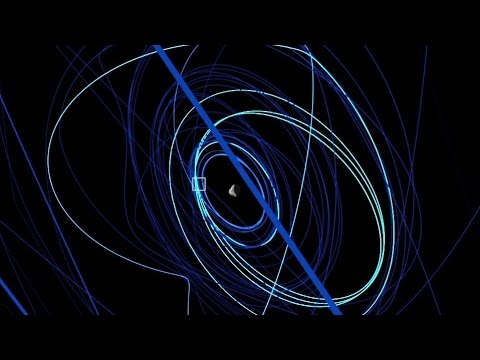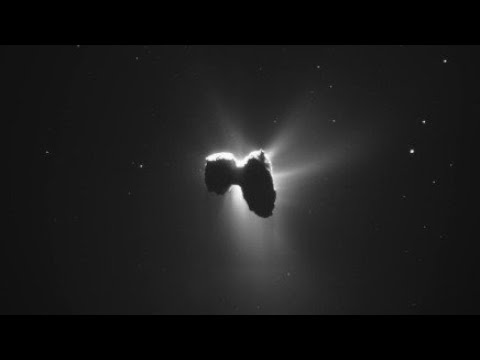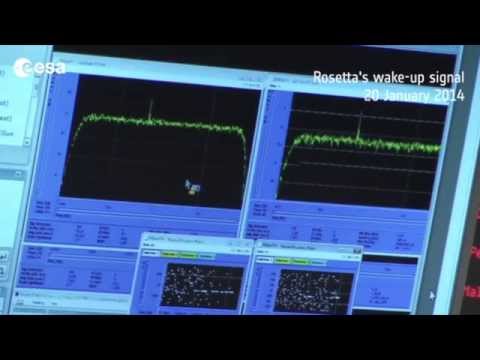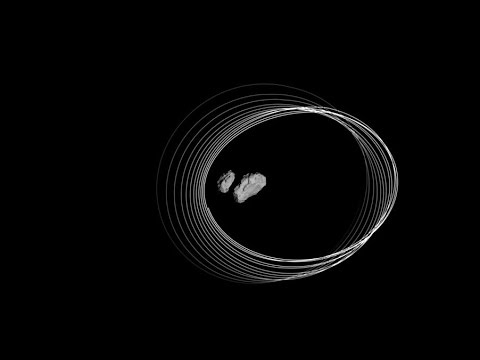Rosetta?s complete journey around the comet
Animation visualising Rosetta?s trajectory around Comet 67P/Churyumov?Gerasimenko, from arrival to mission end.
The animation begins on 31 July 2014, during Rosetta?s final approach to the comet after its ten-year journey through space. The spacecraft arrived at a distance of 100 km on 6 August, from where it gradually approached the comet and entered initial mapping orbits that were needed to select a landing site for Philae. These observations also enabled the first comet science of the mission.The manoeuvres in the lead up to, during and after Philae?s release on 12 November are seen, before Rosetta settled into longer-term science orbits.
In February and March 2015 the spacecraft made several flybys. One of the closest triggered a ?safe mode? that forced it to retreat temporarily until it was safe to draw gradually closer again.
The comet?s increased activity in the lead up to and after perihelion in August 2015 meant that Rosetta remained well beyond 100 km for several months.In June 2015, contact was restored with Philae again ? albeit temporary, with no permanent link able to be maintained, despite a series of dedicated trajectories flown by Rosetta for several weeks.
Following the closest approach to the Sun, Rosetta made a dayside far excursion some 1500 km from the comet, before re-approaching to closer orbits again, enabled by the reduction in the comet?s activity.
In March?April 2016 Rosetta went on another far excursion, this time on the night side, followed by a close flyby and orbits dedicated to a range of science observations.
In early August the spacecraft started flying elliptical orbits that brought it progressively closer to the comet. On 24 September Rosetta left its close, flyover orbits and switched into the start of a 16 x 23 km orbit that was used to prepare and line up for the final descent.
On the evening of 29 September Rosetta manoeuvred onto a collision course with the comet, beginning the final, slow descent from an altitude of 19 km. It collected scientific data throughout the descent and gently struck the surface at 10:39 GMT on 30 September in the Ma?at region on the comet?s ?head?, concluding the mission.
The trajectory shown in this animation is created from real data, but the comet rotation is not. Distances are given with respect to the comet centre (except for the zero at the end to indicate completion), but may not necessarily follow the exact comet distance because of natural deviations from the comet?s gravity and outgassing.?An arrow indicates the direction to the Sun as the camera viewpoint changes during the animation.
More about the Rosetta mission:
http://rosetta.esa.int





Why is all that sharp right angle manoeuvres????
It was postponed asteroids in the solar system.
Break out, with centrifugal force, gravity-free status, weight and no force.
Situated in the vacuum of the solar universe, with a strong position in the orbit of its own.When it closer or into the radius of gravity.
The planet has a moon, it will run into bumps or the planet itself.
With gravity. This is my opinion
Right or wrong, depending on the agency's survey consider this opinion.
At 0:38, does anyone know how much DeltaV was needed to reverse the orbit?
#Once upon a time..
Adding music would make this better, also u could end by zooming out to show entire orbital path rather than just the close fly by and circular orbits.
Sutch a mission !
That was great to follow step by step.
Even if Philae didn't manage to land properly, it was a fantsatic mission and I'm sure the data gathered there is going to be useful.
Bravo ESA.
Can we get this in?3D?
rip rosetta
What a ride!!!
Awesome!
For all those skeptics who voiced doubts about the Rosetta mission, I hope this gives you some satisfaction. https://rosetta.jpl.nasa.gov/
But if this is not good enough, here is the search page (below) from which I got the above link. https://www.google.com/search?q=rosetta+space+probe&oq=rosetta+space+probe&aqs=chrome..69i57j0l5.20940j0j7&sourceid=chrome&ie=UTF-8
And if THIS leaves you with some lingering doubts, then you can go back to the Flat Earth page from which you came. Cheers!